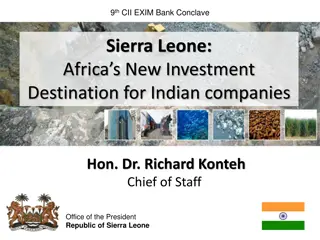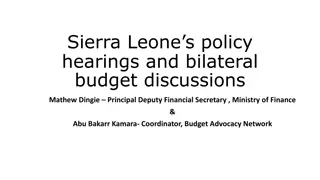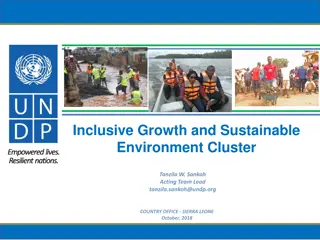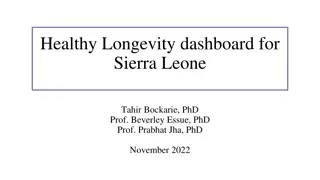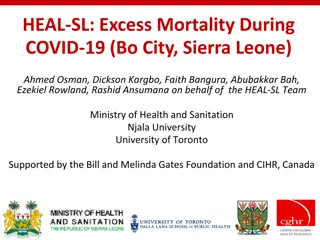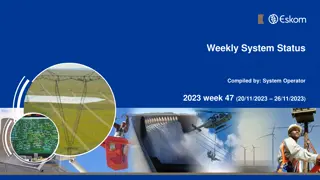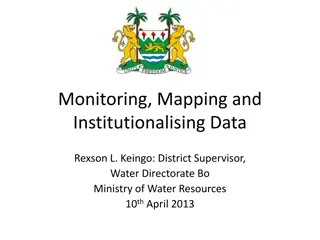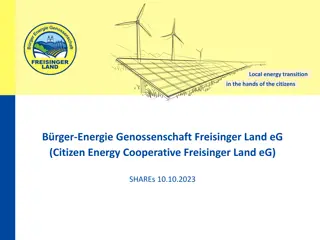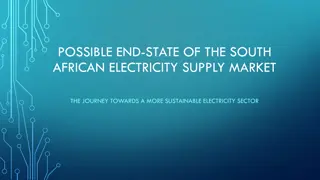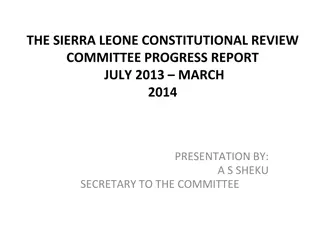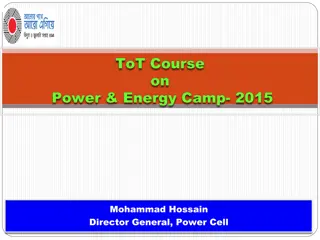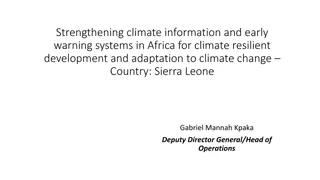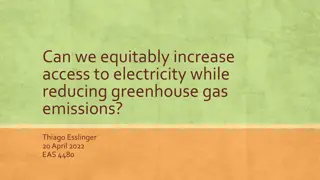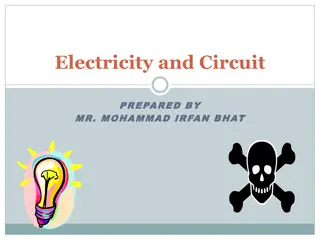Strategic Priorities for Sustainable Electricity Generation in Sierra Leone
The Ministry of Energy in Sierra Leone has outlined strategic priorities to ensure sustainable electricity generation and supply in the short, medium, and long term. Key actions include implementing an integrated electricity plan, identifying externally funded projects for power supply, and addressing commercial and technical losses. The government aims to provide low-cost and flexible thermal capacity to ensure year-round power supply, with a focus on utilizing solar PV generation and efficiency gains to mitigate costs. Plans also involve delivering a least-cost generation capacity mix and importing energy to meet increasing demand, with a preference for hydro and solar options.
Download Presentation

Please find below an Image/Link to download the presentation.
The content on the website is provided AS IS for your information and personal use only. It may not be sold, licensed, or shared on other websites without obtaining consent from the author. Download presentation by click this link. If you encounter any issues during the download, it is possible that the publisher has removed the file from their server.
E N D
Presentation Transcript
Ministry of Energy Republic of Sierra Leone STRATEGIC PRIORITIES FOR THE ENERGY SECTOR 30 OCTOBER 2019
Overview o Presentation of Key staff o Presentation structure o Strategic priorities 1. Sustainable electricity generation and supply priorities in the short, medium and long term 2. Develop and implement an integrated electricity plan that combines generation, distribution and transmission 3. Identify Externally Funded projects (IPP) for power supply 4. Outline a realistic plan to address EDSA s Commercial and technical losses 2
Strategic priorities 1. Sustainable electricity generation and supply priorities in the short, medium and long term Key Policy Action: Ensure power supply all year around o Policy statement: GOSL will provide low cost and flexible thermal capacity to ensure power supply backup during dry season o Rationale: Contracting Karpowership enabled GOSL to ensure power supply all year around, especially during dry season which was marked by severe load shedding o Challenge: Karpowership is increasing the short-term cost of supply and should be compensated with (i) low cost solar PV generation capacity, (ii) efficiency gains at EDSA and (iii) tariff increase o Opportunity: Karpowership is the best immediate proposition with regards to capacity increase and cost mitigation. Lower cost alternatives (LNG, coal, ) are being explored by MOE. o 3
Strategic priorities 1. Sustainable electricity generation and supply priorities in the short, medium and long term Key Policy Action: Deliver least cost generation capacity mix and import o Policy statement: GOSL plans for developing least cost generation mix with optimal use of national resources and regional trading opportunities in order to match the national demand o Rationale: o Electricity demand is increasing at a rate of 10+% Additional demand will be met by additional supply capacity (generation and import) Large scale hydro generation capacity is the least cost option (< USct 11 per kWh) but will require at least 5 years to build. It is only a long-term option (mid-term opportunity: rehabilitating Goma hydro power station) Large scale solar PV generation capacity (USct 9-11 per kWh) will substitute to thermal generation capacity (USct 13-18 per kWh). Solar PV is a mid-term option (2021-2022) that could also be mobilised in the short- term (2020-2021) if a fast track procurement process is formulated. 4
Strategic priorities 1. Sustainable electricity generation and supply priorities in the short, medium and long term Rationale (cont d): o Import is the only short-term option (2020) thanks to the commissioning of CLSG Transco in June 2020. The current PPA is sourcing import from gas power plant in Cote d Ivoire at a cost of USct 12.5 per kWh (+ USct 2.0 per kWh TRANSCO transmission charge). It will not improve the sector financial sustainability but will protect the sector from insufficient in- country generation capacity Challenge: Readiness to import up to the quantity prescribed in the PPA (27 MW) at the commissioning of CLSG Transco through specific links to be developed by EGTC (161 kV link at Bumbuna) and EDSA (33 kV links at Kenema and Koidu). o Opportunity: Purchase likely excess hydro power from Guinea (if not absorbed by their mining sector in the short term) and release Guinea of its obligation to import from Cote d Ivoire through CLSG Transco (if they don t need power import). o 5
Strategic priorities 2. Develop and implement an integrated electricity plan that combines generation, distribution and transmission Key Policy Action: Planning for the development of national electricity supply service o Policy statement: GOSL will plan for the development of the electricity infrastructure in order to serve the highest possible public good (i) in the shortest time possible, (ii) at the least cost associated with time horizon and (iii) in the most inclusive way o Rationale: o Least cost generation and transmission development plan (specifying renewable and thermal generation capacity, and deployment of the transmission corridors) On-grid distribution development plan (strengthening and expansion of on-grid distribution services in clusters around district capital cities) Off-grid supply development plan (mini-grid electrification of rural towns and villages, rural off-grid electrification, urban off-grid electrification) 6
Strategic priorities 2. Develop and implement an integrated electricity plan that combines generation, distribution and transmission Rationale (cont d): o Sector Wide financial model translates the electric infrastructure plan in financial expenses and revenues with a focus on the public sector. The financial model provides a forecast of the financial statements (income statement and balance sheets) of the public owned entities (EDSA and EGTC). The Financial Sustainability Plan shows a trajectory towards sector financial sustainability. It forecasts the future electricity sector deficit milestones until structural conditions for sector sustainability are met, i.e. (i) optimal expansion of served population and economic sectors, (ii) optimal efficiency of EDSA and (iii) optimal cost of the electricity generation and import mix. Challenge: Capacity of the Ministry of Energy and uncompleted institutional reform of the sector (and non delivery of expected outcome of the reform) o Opportunity: Establishment of a Planning Unit and Rural Energy Unit at MOE and completion of the roadmap for the reform of the electricity sector o 7
Strategic priorities 3. Identify Externally Funded projects (IPP) for power supply Key Policy Action: Mobilise funding for implementing the power sector development plan o Policy statement: GOSL will ensure the mobilization of financing requirement with the right public/private finance mix in respect of public finance constraints o Rationale: o Externally funded projects have covered the entire value chain of the sector Generation (JICA grant for the HFO power plant in Freetown, ADF loan for solar PV project, ECOWAS fuel emergency fund, ) Transmission (India Exim Bank loan for the North Corridor, WB & EIB loans for TRANSCO) Distribution (ESURP programme of the World Bank, ADB loan, JICA loan, IDB loan) Off-grid supply (RREP programme managed by UNOPS and funded by DFID, EU funded programme, USTDA grant, ROGEP managed by ECREEE and funded by WB) Institutional reform support (WB, MCC, DFID ) 8
Strategic priorities 3. Identify Externally Funded projects (IPP) for power supply Rationale (cont d): o All donor money is provided through financing agreements with GOSL and is considered as resources for public finance Public finance capability over the mid-term has been captured in the Mid- Term National Development Plan released by MOPED in 2019. When compared to sector financing requirement (CAPEX and Sector deficit), the public finance capability is a fraction (25-30%) of the finance required. As a result, GOSL will have to mobilise private finance in order to meet financing requirement for the sector development. Financing requirement for generation account for 50-60% of the entire financing requirement for the electricity sector and could be entirely developed with private finance Private finance will have to be also mobilised to some extent in the distribution segment (rural mini-grids and also electricity supply services in currently unserved district capital cities) in order to match sector financing requirement with the right public/private finance mix. 9
Strategic priorities 3. Identify Externally Funded projects (IPP) for power supply Challenge: All projects (except HFO Barge and WAPP import) have a lower level of maturity o Opportunity: The pipeline of generation projects is sufficient to meet the requirements over the long term o Project Fuel Capacity (MW) 30-120 15-45 96-128 6 COD Date feasibility Commercial close Yes Yes No No Financial close n/a Yes No Yes HFO Gas HFO PV 2018-2022 2020-2022 2023-2027 2020 Yes Yes Yes Yes HFO Barge WAPP import Kissy HFO Freetown Solar Park Planet Core Solar PV Other Solar PV Bekongor HPP Bumbuna 2 HPP Yiben HPP LNG power plant Coal power plant PV 50 2020 No Yes No PV Hydro Hydro Hydro LNG Coal 75-125 160 86 55 150 150 2022-2023 2025 2027 2027 No Yes Yes No No No No No No No No No No Yes No No No No 10
Strategic priorities 4. Outline a realistic plan to address EDSA s Commercial and technical losses Key Policy Action: Reduce EDSA s grid loss to sustainable level o Policy statement: GOSL is engaged to make use of all institutional leverages in order to curb drastically EDSA s grid losses o Rationale: o The sector financial model estimates EDSA s grid loss at 45% with a current trend to increase (EDSA grid loss needs to be assessed by an independent source) Most of EDSA s grid loss are in the last mile of the grid and are related to power theft Failure to address effectively this problem has resulted in the perception of impunity and growth in corrupt practices Challenge: EDSA has the highest level of grid loss in ECOWAS Member States o 11
Strategic priorities 4. Outline a realistic plan to address EDSA s Commercial and technical losses Opportunity: MOE has set-up a realistic plan in 4 steps o Step 1: Ensure sufficient supply of meters through a meter asset provider solution where meters are directly purchased by new customers from accredited vendors. Step 2: Develop the inspector function of the regulator (EWRC) as provided in the Law. EWRC has the mandate to assign efficiency improvement obligation to distribution licensee and has the power to mobilise inspectors in order to verify that the obligation is fulfilled. Step 3: Launch a national communication campaign on the end of impunity for offence to the Electricity Act and a call for self-disclosure for customers in illegal situation or illegal abstractors Step 4: Explore the feasibility for outsourcing the commercial and supply function of EDSA to the private sector through distribution franchise agreements over specific territorial perimeters 12
Ministry of Energy Republic of Sierra Leone THANK YOU
Policy Actions A1. Based on Energy Roundtable (30 Sept 1 Oct 2019) MOE to agree with MOF on a sector deficit cap for 2020 and adjustment measures if the cap is likely to be exceeded (tariff increase, supply constraint) o MOE to agree on a baseline least cost development plan based on feasible and bankable projects and alternative scenario based on still uncertain options o MOE to develop an LNG supply option in the Least Cost Generation Plan, including assessment of the cost of LNG supply chain and cost of a gas fired power plant under various technology options; MOE to determine the best options for Sierra Leone including (i) shipping LNG to mining sites for self- generation (ii) enabling the mines, as eligible customers, to purchase electricity directly from LNG power plant connected to the proposed LNG storage terminal in Freetown and wheel it through the transmission grid. o MOE to take ownership of the sector financial model and compute the forecast of average cost of generation mix based on generators commissioning / decommissioning plan o EWRC to prepare a tariff trajectory methodology and to ensure that they have tools and capacity to implement it o 14
Policy Actions A1. Based on Energy Roundtable (30 Sept 1 Oct 2019) cont d MOE to prepare a sector development plan including strategy, policy and financing plan o MOE to agree on a mid- to long-term financial sustainability plan o o MOF to invite Donors to support sector financial loss against the implementation of the financial sustainability plan; it could be a loan with a 5- year grace period and start of repayment at the date scheduled for sector financial sustainability (tariff levy) MOE to mandate EWRC to verify the number of connections to mini-grids and ensure that all categories of population are benefitting of power supply opportunity from mini-grid operators o EWRC to review the affordability of mini grid supply to poor households o EWRC to review the competitiveness of mini-grid supply to wealthy households with self-generation options (solar home systems and/or genset) o 15
Policy Actions A2. Based on CLSG operationalization workshop (9-10-11 October 2019) MOE to check the payment guarantee requirement and liability exposure resulting from (i) the Transmission Services Agreement (TSA) signed between Transco and NPA and (ii) the Power Purchase Agreement (PPA) signed between CI Energies and NPA o MOE to advise how to split the liability exposure between EDSA and EGTC (and possible private operator) o MOE to advise on the fiscal risk resulting of the binding agreements signed under the CLSG project o MOE to check the Performance obligation requirement and resulting from the Power Purchase Agreement (PPA) signed between CI Energies and NPA and from the Transmission Services Agreement (TSA) signed between Transco and NPA o MOE to check the financial arrangement resulting from the loop flow through CLSG Transco with the transmission of power generated by Bekongor HPP to Freetown through the South Corridor o 16
Policy Actions A2. Based on CLSG operationalization workshop (9-10-11 October 2019) Cont d EGTC to determine the feasibility to sign mutual support agreement with neighbouring TSOs; this type of service cannot be provided directly by CLSG Transco and provides financial benefit to SL (reduction of system operating cost in SL) o There is a Transmission Services Agreement (TSA) signed between Transco and NPA. TRANSCO will interconnect with EGTC at high voltage level but also with EDSA at medium voltage level and also with rural distribution licensees that could be different from EDSA. These are three different legal parties to the interconnection agreement. For each party there will be connection requirements (criteria for access to the interconnector) and operating rules all part of the interconnection agreement. o 17
Policy Actions A3. Based on mini-grid feasibility study launch workshop (15 October 2019) EWRC to safeguard potential conflict of interest in the selection of sites for the feasibility study conducted by Windgen/Powergen o EWRC to manage the obligation for mini-grids to provide an affordable and cost- effective electricity supply solution to everyone, including poor households o MOE to define a policy for grid service extension considering the poor efficiency of EDSA and the latest development and performance of third generation mini-grids. This could be an option for developing electricity service in unserved district capital cities. o MOE Rural Energy and Planning Unit to verify that the proposed mini-grid sites are in accordance with the integrated planning principles o MOE to develop a feed-in tariff policy in order to make use of the natural resources of Sierra Leone near grid / mini-grids o o EWRC to specify minimum performance criteria of mini-grid 18
Policy Actions A3. Based on mini-grid feasibility study launch workshop (15 October 2019) cont d MOE to setup a process that builds the capacity of local councils in formulating and assessing mini-grid propositions made in their constituancy o MOE to coordinate various surveys and market assessments in Sierra Leone in order to avoid duplication and promote synergies. In particular, value addition of a new survey compared to a previous survey completed should be assessed. o MOE to supervise the building of a credible dataset for off-grid electricity supply consisting of project overviews, including information on system specifications, cost and performance with contextual details (this is part of the roadmap recommendation). o MOE to establish regional and national data co-operation to foster off-grid electricity supply systems scale-up, monitor progress and assess business barriers. o 19






